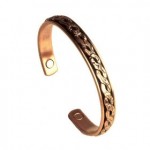 Folklore remedies for pain and inflammation support these bracelets to treat rheumatoid arthritis.
Folklore remedies for pain and inflammation support these bracelets to treat rheumatoid arthritis.
Researchers at The University of York, in the UK studied their effects.
First, the details.
- 70 patients with painful rheumatoid arthritis, aged 33 to 79 years and predominantly female participated.
- They were randomly assigned to each treatment group for 5 weeks, with 1 week between treatments.
- A standard (1502 to 2365 gauss) magnetic wrist strap
- A demagnetized (less 20 gauss) wrist strap
- An attenuated (250 to 350 gauss) magnetic wrist strap
- A copper bracelet
- A change in pain based on the recording on a 100 mm visual analogue scale was the main outcome.
- The McGill Pain Questionnaire and tender joint count were also used to measure pain.
- Inflammation was assessed using C-reactive protein and plasma viscosity blood tests and by swollen joint count.
- C-reactive protein rises when there is inflammation throughout the body.
- Physical function was assessed using the Health Assessment Questionnaire (Disability Index).
- Disease activity and medication use were also measured.
- Neither the patients nor researchers knew the treatment given — double blind.
- 65 participants provided complete results and are the source of the results.
And, the results.
- There were no statistically significant differences between the 4 devices in terms of effects on pain, inflammation, physical function, disease activity, or medication use.
The bottom line?
In this study of people with rheumatoid arthritis (an autoimmune condition) not to be confused with osteoarthritis (associated with aging), the authors concluded, “Wearing a magnetic wrist strap or a copper bracelet did not appear to have any meaningful therapeutic effect, beyond that of a placebo, for alleviating symptoms and combating disease activity in rheumatoid arthritis.”
A review of CAM treatments for rheumatoid arthritis published last year included just 1 using static magnets. There were no positive comparative effects on pain but some benefit as reported using patient global assessment .
Magnet therapy is arguably more popular now than at any other time in history. They are relatively inexpensive, generally safe, and wearers may perceive some pain relief. Accordingly, there’s no advantage in arguing against them as long as they don’t delay allopathic treatments, which are most effective when started early in the disease.
10/1/13 10:25 JR